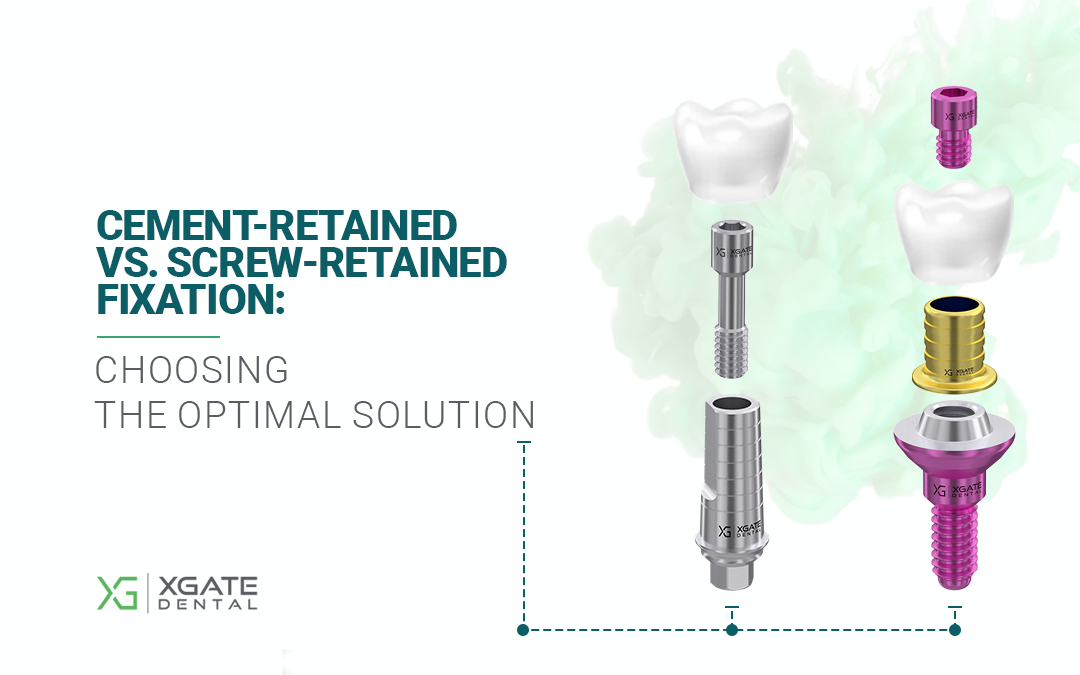The debate continues regarding which type of retention is superior. New studies are constantly published, and the conclusion remains: both retention methods are effective and widely used. This is supported by a review for the 2009 consensus conference (within the ITI) by Dr. Salvi and his team from the University of Bern.

The choice of method depends on the specific clinical case. This article examines the less obvious advantages and disadvantages of each option.
Contents
Implant-Supported Prostheses Retention Options
Let’s explore the main types of retention for implant-supported restorations. This classification is not definitive or officially recognized, but it is practically useful.
Fixed and Conditionally Removable Structures
- Cement Retention: Considered non-removable. While a dentist can remove the restoration, reusing the same prosthesis is questionable and depends on the type of cement used.
- Screw Retention: A conditionally removable option, allowing relatively easy removal and replacement of the prosthesis. There are several subtypes: Multi-unit abutments are commonly used for multi-unit restorations, modified conventional abutments or specialized Ti-base abutments are used for single unit restorations. We will examine these in greater detail.
- Cement-Screw Retention: A hybrid option used infrequently, but useful when screw retention on multi-unit abutments is not feasible.
Removable Structures Supported by Implants – The patient can remove and reinsert the prosthesis:
- Rigid Retention: Includes prostheses supported by bars, locators, and telescopic copings.
- Semi-Rigid Retention: (Ball attachments, locators). These systems use silicone caps between the prosthesis and supporting abutments to compensate for uneven loading. The primary disadvantage is that a significant portion of the load is transferred to the soft tissues, unlike other options where the load is primarily borne by the implants.
- Frictional (Telescopic) Retention: The prosthesis can utilize a prepared tooth or an implant as a support. The method relies on precisely fitted abutment/coping pairs. The abutment remains on the implant, and the coping is cemented into the prosthesis. Frictional force holds the prosthesis in place, allowing easier removal compared to cement retention.
This discussion focuses on comparing screw and cement retention, the two most common and reliable systems.
Advantages and Disadvantages of Screw Retention
Screw retention offers a distinct advantage: it allows prosthesis placement when the distance between the implant platform and the opposing tooth is less than 7 mm. Attempting a cement-retained restoration in such cases will likely result in insufficient retention, as the abutment height for cement adhesion will be only 3-4 mm, which is inadequate.
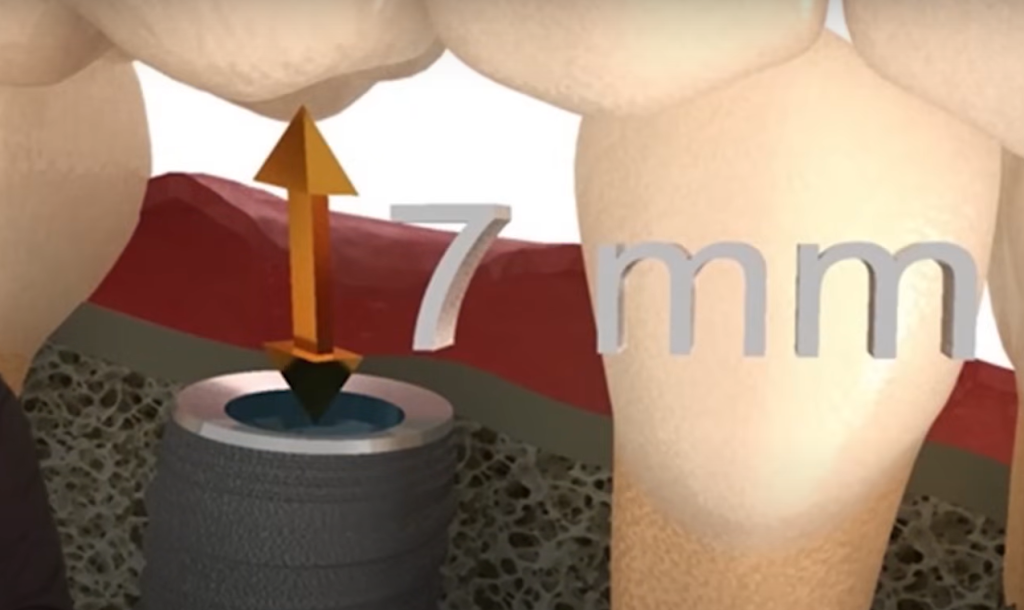
Direct indication for screw retention – the distance between the implant and the antagonist tooth is 7 mm or less YouTube / Rauf Aliyev / Implantarium
The development of the XGATE Dental multi-unit V-type abutment, with a height of only 1.5 mm, addresses even more challenging situations where the distance to the antagonist is no more than 4 mm. While the prosthesis strength may be compromised, this solution is preferable to grinding down or extracting the opposing tooth.
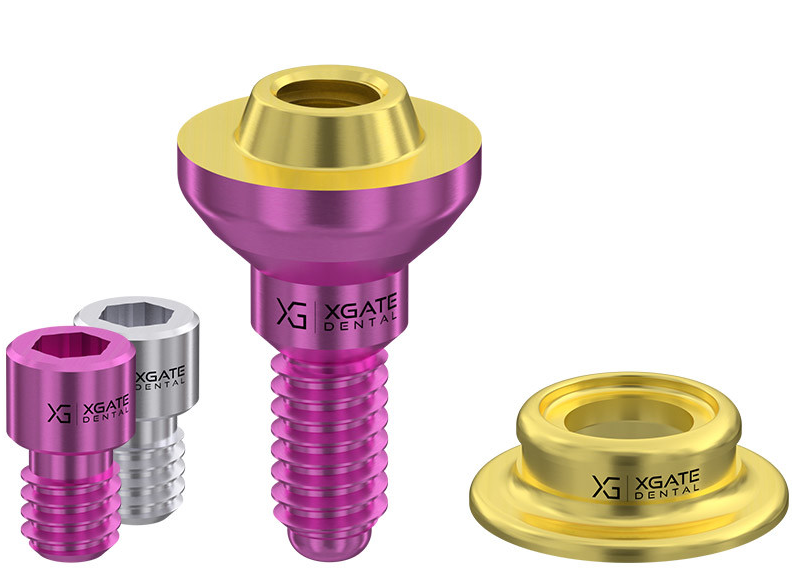
Generally, low-profile multi-unit abutments solve many difficult situations. Sometimes, an angled multi-unit abutment can be avoided if the implant deviates only slightly from the occlusal plane, but this will be addressed in a separate article.
Let us recall that there are two basic types of screw retention:
- Restoration of Single Defects. The crown is attached to the abutment extraorally (outside the patient’s mouth), allowing complete removal of cement residues. The abutment-crown complex is then attached to the implant with a single screw. This is also known as “screw-retained to implant” retention.
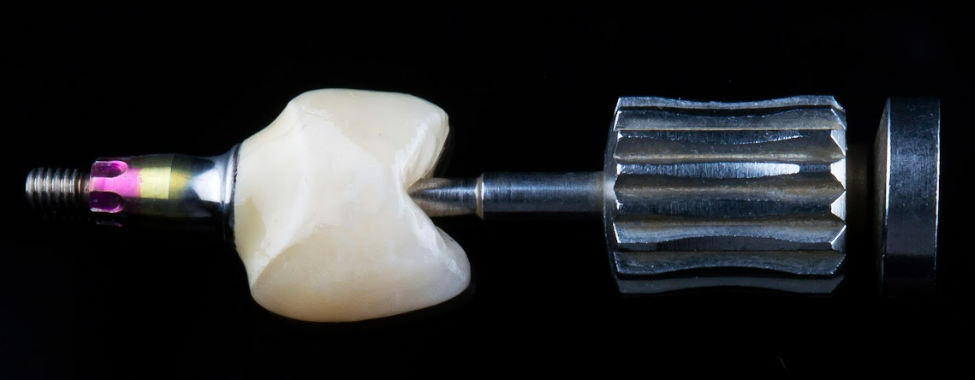
Crown with screw-retained abutment (single defect) (image from Shutterstock)
Specialized abutments, like Ti-base abutments (XGATE Dental) or commercially milled abutments suitable for cementation, can be used. The key is the presence of anti-rotational elements to prevent crown rotation relative to the abutment.
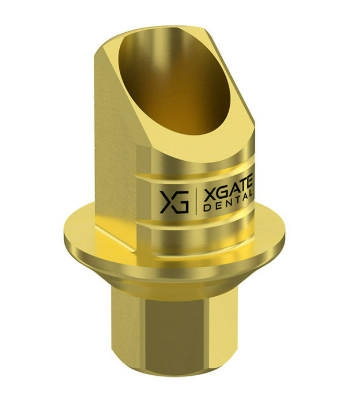
Ti‑base abutment for screw‑retained single restorations A characteristic feature is the screw access channel on the occlusal surface of the crown, which is filled with composite resin. This process is similar to filling cavities in caries treatment. The composite can be removed to access and unscrew the screw, allowing easy removal of the crown and abutment, which is not always possible with cement retention. - Restoration of Multiple Defects. Multi-unit abutments (MUAs) are designed for these restorations. The abutment is secured to the implant with a separate screw, and the prosthesis is attached to the fixed abutments with individual screws. This simplifies achieving a passive fit, as the dental technician only needs to fabricate a prosthesis that fits onto the conical heads (approximately 3.5 mm high) of the multi-unit abutments, rather than deep within the implant interface. See the illustration below: A D-type multi-unit abutment with integrated screw on the shank, a sleeve that is retained in the prosthesis and separate screws for attaching the prosthesis to the multi-unit abutment (MUA).
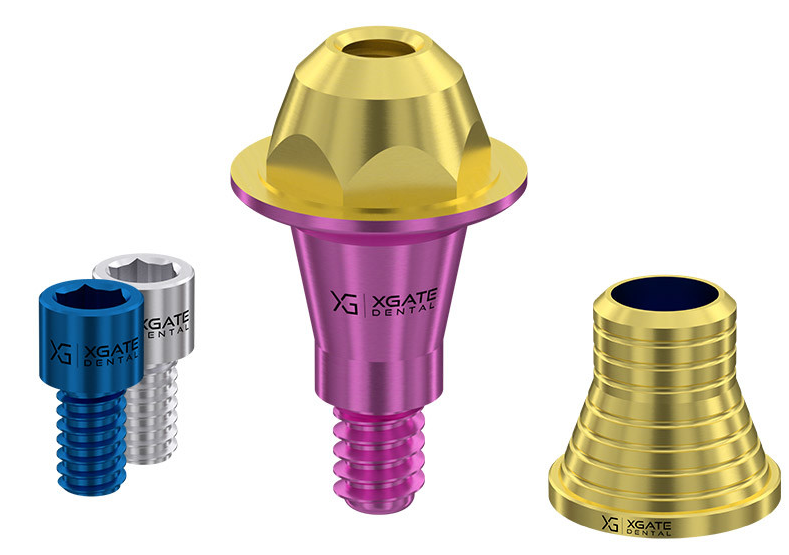
D‑type multi‑unit abutment with CAD/CAM short sleeve and retaining screws
Prostheses for retention on multi-unit abutments look like this.
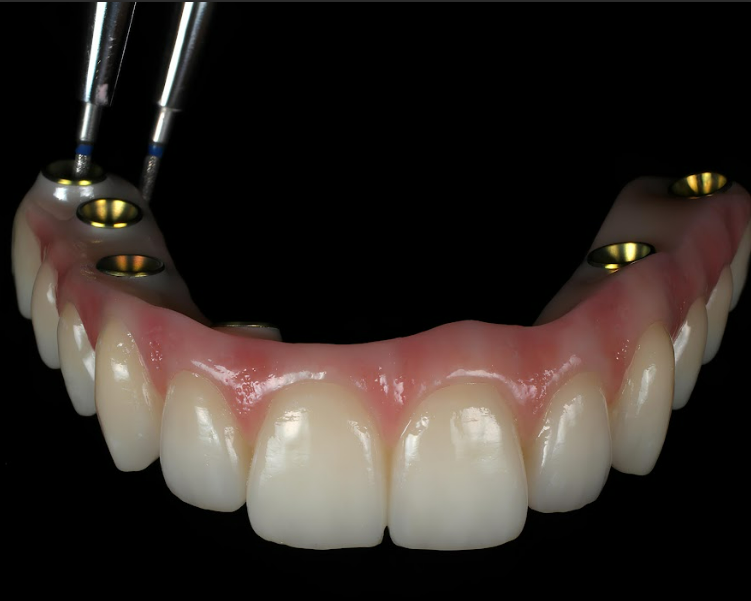
Maxillary full-arch prosthesis for screw retention on multi-unit abutments (image from Shutterstock)
Both straight and angled multi-unit abutments exist. Angled abutments compensate for significant implant angulation, particularly with the All-on-4 and All-on-6 prosthetic protocols, where distal implants are typically placed at a steep angle relative to the occlusal plane.
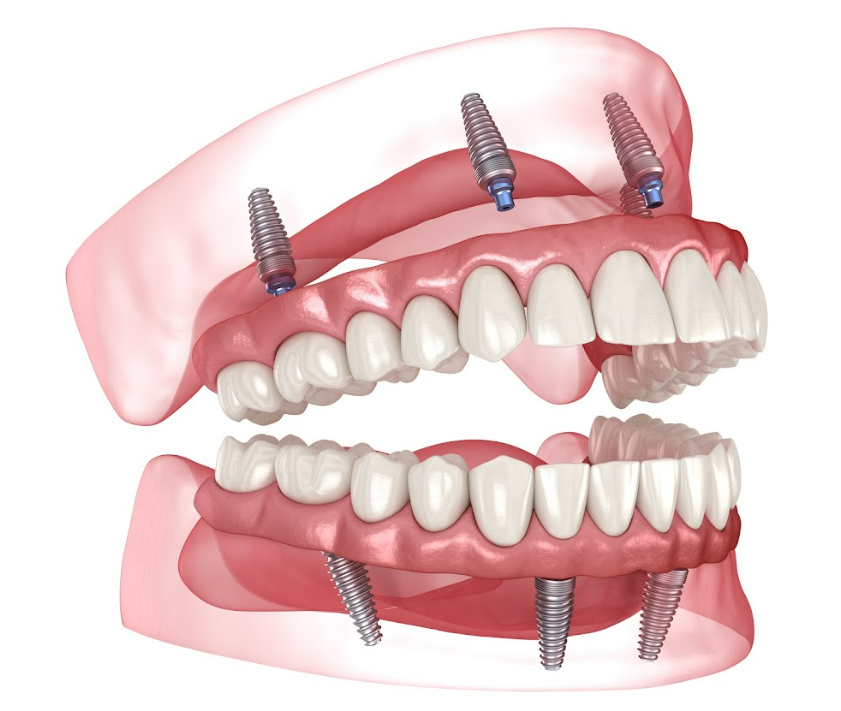
One of the options for placing implants in the All-on-4 prosthetic protocol (from Shutterstock)
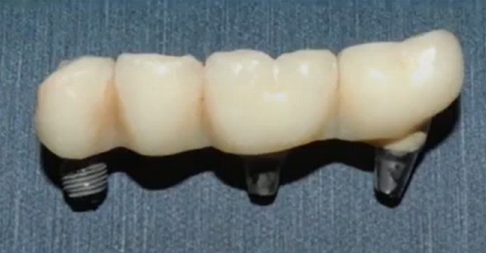
підпис
Returning to the advantages of screw retention:
- Easily Compensates for Angular Discrepancies Between Implants in Multiple Restorations. The short (approximately 3.5 mm) conical interface between the bridge and multi-unit abutments simplifies creating a well-fitting prosthesis on slightly non-parallel cones. Angled multi-unit abutments can correct even significant implant angulation, as illustrated below.
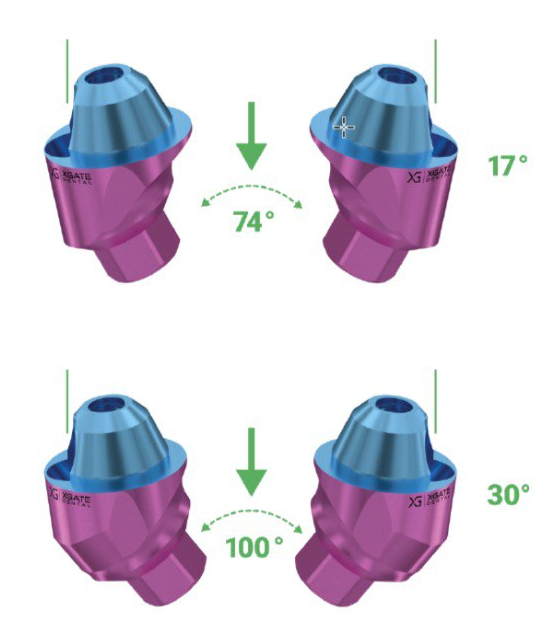
Angled multi-unit abutments by XGATE Dental make it possible to compensate the angles between implants within a very wide range: abutments 17° – angle 74°; abutments 30° – angle 100°
- Enables Cantilever Structures. MUAs have made restorations like All-on-4 and All-on-6 possible, where large cantilevers extend distally. Only screw retention provides sufficient strength for these designs.

An example of a denture prosthesis according to the All-on 4-protocol – the prosthesis has significant (more than 15 mm) cantilever parts in the chewing area (image from Shutterstock)
- Screw Retention is Essential for Removable Bar-Supported Prostheses. The bar is securely attached to the implants with screws, and the prosthesis is attached to the bar with different types of attachments. The bar can be manufactured very precisely, without temperature influences and can be placed on implants without internal stresses. Uniform load distribution ensures mechanical reliability and preserves the bone around the implants.
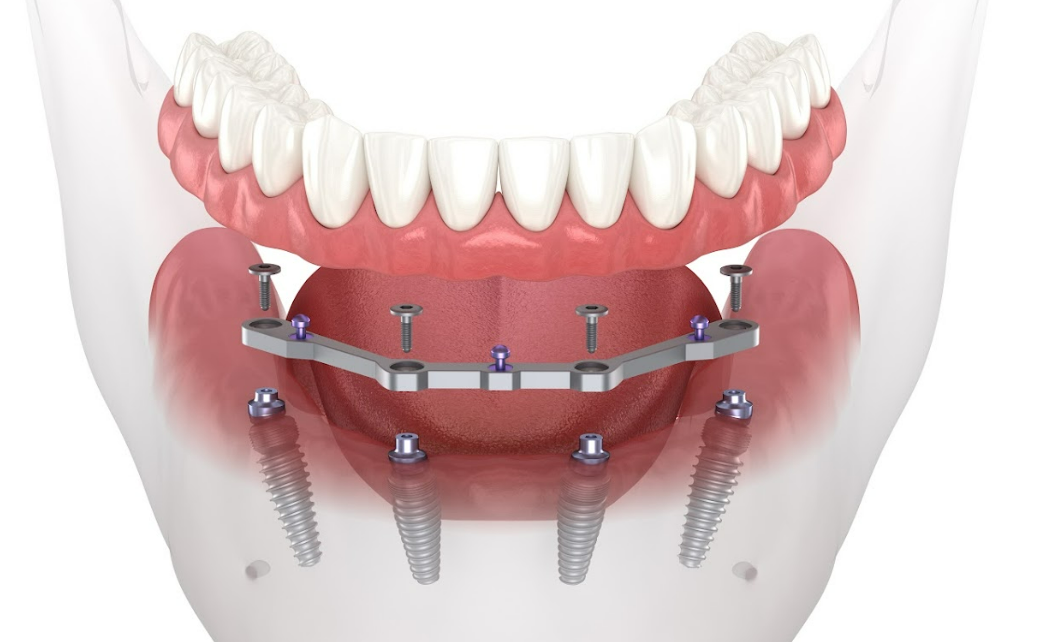
An example of implant-supported bar prosthetics (image from Shutterstock)
- The Screw-Retained Prosthesis is Easily Removable. The composite filling the screw access channels is drilled out, and the screws are unscrewed.

An example of installing a small bridge with a screw retention YouTube / Dr. Kamil Khabiev / Dental Guru Academy
- Eliminates the Risk of Cement Contacting the Gingiva. This is especially important for patients with a history of periodontitis. Even if the condition is treated and asymptomatic during the prosthetic phase, even a small amount of subgingival cement can cause inflammation.
Disadvantages of Screw Retention
- Compromised Aesthetics due to Screw Access Channels. It’s crucial to position the screws on the lingual/palatal surface of anterior restorations.
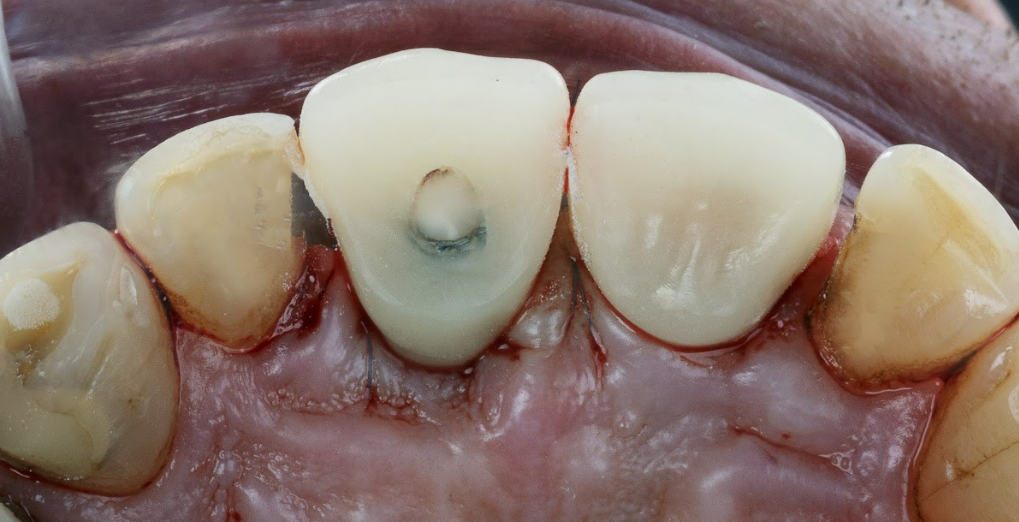
Screw exit to the inside of the crown (image from Shutterstock)
This can be problematic because implants in the aesthetic zone are often placed with some angulation. The composite filling the screw access channel can discolor over time, becoming visible against the prosthesis.
- Increased Incidence of Bad Breath. The absence of cement filling the space between the abutment and prosthesis creates micro-gaps where biofilm can develop. Removing the biofilm requires prosthesis removal. High-precision prostheses may minimize odor, noticeable only upon removal.
- Potential for Ceramic Chipping and Zirconia Fractures. The screw access channel weakens the structure, increasing the risk of chipping or fracture. However, the overall risk remains low. Most prostheses last for years, regardless of retention type.
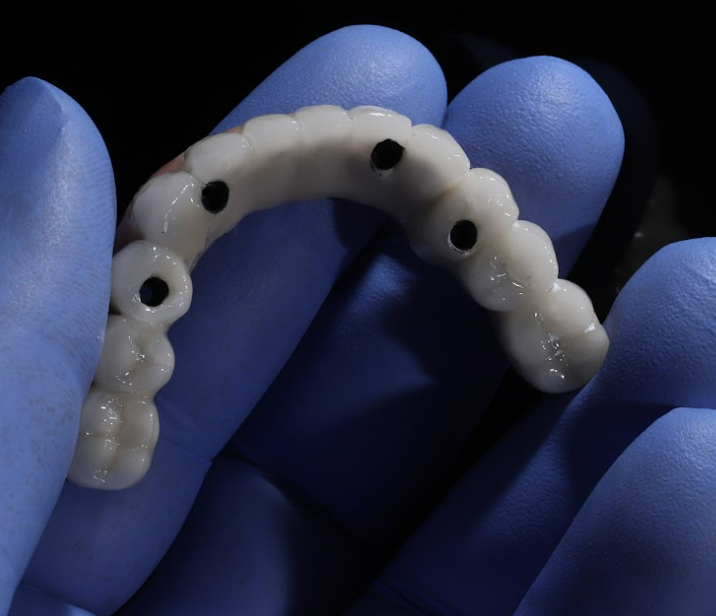
Example of zirconia bridge with screw access channels that may weaken the structure
- Functional Cusp Interference. If the screw access channel is not centered within the crown but passes through a functional cusp, the composite in that area will wear down quickly, impairing chewing efficiency. Regular inspections and composite replacement are necessary.
Mechanical Aspects of Screw Retention
To understand the difference in reliability between screw retention directly to an implant and to a multi-unit abutment, let’s consider specific examples. Recall that retention to the abutment means a single-screw connection. The crown is cemented to the abutment extraorally, and then the crown-abutment complex is installed onto the implant and secured with a screw. This is suitable for single-tooth restorations, but less ideal for bridges supported by two or more implants. The images below show a cast metal framework for a metal-ceramic restoration connected to abutments. The finished prosthesis was then placed on implants, revealing fit issues. The images clearly show gaps between the abutment and the implant body. This resulted from inaccurate fabrication, causing significant internal stress and leading to implant failure.

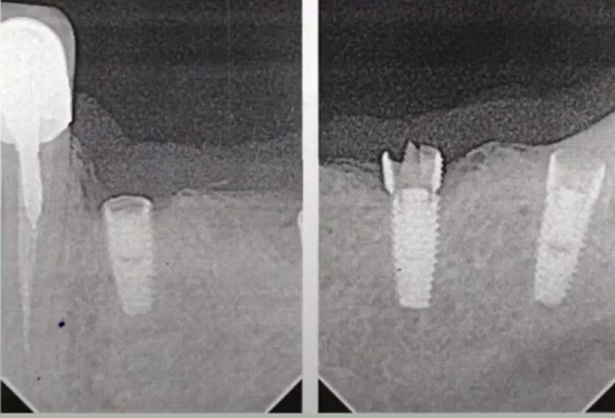
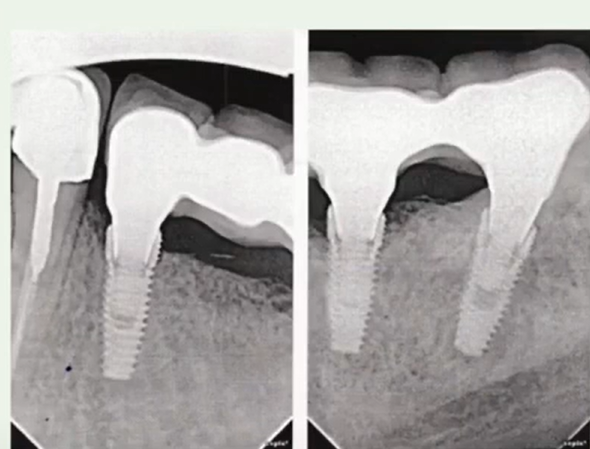
Unsuccessful fit of the restoration with internal stress leading to implant failure YouTube / Dr. Kamil Khabiev / Dental Guru Academy
Consider the difference in the effect of deviation from the planned position and the length of the lever arm, with the same inaccuracy in the manufacture of the frame for the multi-unit abutment vs. for the cast abutment. When the screw is attached directly to the implant (left image), the lever arm length (from the edge of the retaining screw to the top of the frame/crown) is 8-10 mm. The deviation from the design position at the top of the crown will be significant, around 2.5 mm (red line). If the frame is attached to a multi-unit abutment, the lever arm length starts from the MUA platform. With the same angular error, the deviation is much smaller, less than 1 mm (red line in the right image). Since the MUA fits perfectly in the implant without gaps, the risk of implant fracture is minimal. If a problem occurs, the screw connecting the MUA to the restoration will loosen or break, acting as a mechanical fuse.
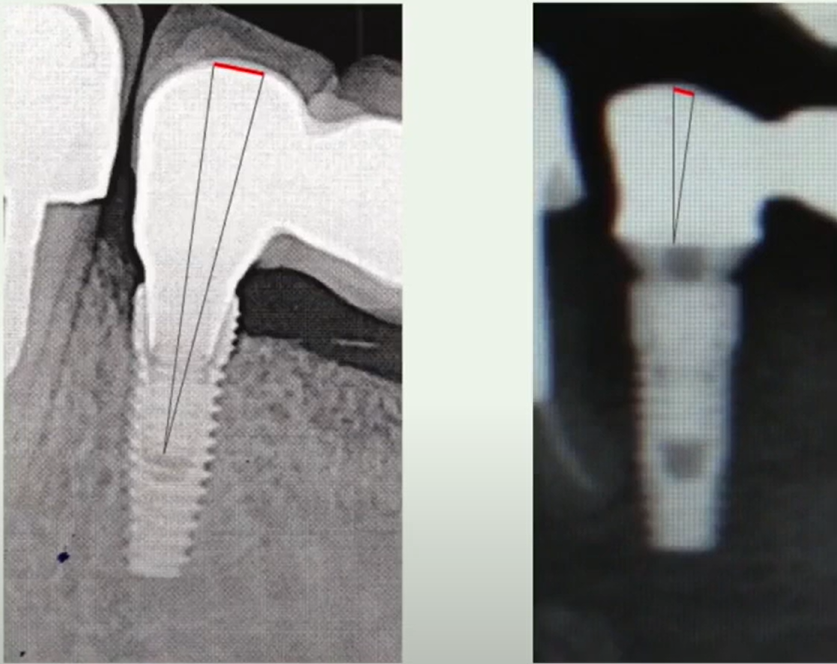
Difference in deviation of the installed restoration when using screw retention to an implant (left) and to a multi-unit abutment (right)
As you see, the same manufacturing error produces vastly different errors in the final restoration. Therefore, we recommend using MUAs even for simple two-implant bridges. The amount of deviation depends on the distance from the defect point and the angle. The table below shows that the further from the defect, the greater the deviation.
Lever height (from the edge of the screw to the top of the crown), mm Deviation angle 2° Deviation angle 5° Deviation value, mm Deviation value, mm 5 0,17 0,43 10 0,35 0,87 15 0,52 1,3 20 0,7 1,75 If the lever arm length for an MUA-supported crown rarely exceeds 5 mm, even with a 5° deviation, the discrepancy from the planned position will be less than 0.5 mm. For direct implant retention, where the lever arm often exceeds 10 mm, a 5° deviation at 15 mm translates to a 1.3 mm deviation, which is significant. At a minimum, you will have to redo the crowns in the places of contact with neighboring teeth, and most often, you will have to redo the entire prosthesis.
Advantages and Disadvantages of Cement Retention
In cement retention, the crown or bridge is held onto the abutment by cement. Several types of cement exist:
- Temporary Cement: Characterized by low bond strength. Research shows bond strengths ranging from 4.52 to 17.82 N. This wide range reflects the influence of abutment shape (conical vs. straight), height (4 mm vs. 7 mm), and contact area. Superficially, the holding force is insufficient. Even some types of sticky food such as caramel can produce a tearing force of about 18N, which means that the guaranteed retention force of the prosthesis must be at least 20N. However, temporary cements have also been successfully used for permanent prostheses. It all depends on the accuracy of manufacturing the abutments or crowns. Modern technologies such as CAM/CAD allow us to produce abutments and crowns with the highest precision. Notice in the image below that the abutments are straight (with parallel walls), and the anti-rotation ridges are visible inside the crowns (in the second image). In addition, such a groove and protrusion provide only one way to install the crown; it is impossible to make a mistake. This crown/abutment pair holds very firmly, almost at the level of frictional retention, and does not require high-adhesion cement.
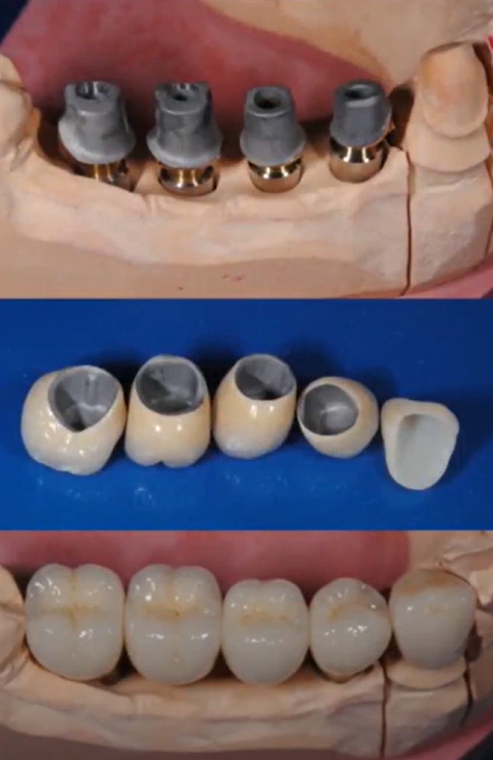
Custom abutments and crowns manufactured with the highest precision YouTube/Dr. Kamil Khabiev / Dental Guru Academy
Such dentures hold quite tightly even without cement. And when trying on, you need to make an effort to remove the prosthesis. In this case, temporary cement successfully complements the retention and such a restoration lasts for years. And when you need to remove the prosthesis, this also does not cause serious problems.
- Semi-Permanent Cement: Seemingly ideal. Research indicates holding forces of 50-200 N, which is generally above the required 20 N. However, the range is still broad, and removing a restoration with a holding force of 180-200 N without damage can be difficult.
- Permanent Cement: Offers high holding forces of 72-210 N for reliable retention, but removal without destruction is challenging. One technique involves drilling through the prosthesis at the screw access locations and removing the prosthesis with the abutments, similar to screw retention. This minimizes patient discomfort.
The search for the “ideal” cement continues, with specialists selecting materials based on their preferences and techniques.
Expanding cements exist but are not widely used. Unlike adhesive cements, expanding compounds are similar to spray foam. Excess material extending beyond the crown margin is more difficult to remove than conventional cement.
Advantages of Cement Retention
- Easier crown and bridge fabrication.
- Superior aesthetics: No screw access channels.
- Compensation for stress and manufacturing inaccuracies. If a dental technician makes flow restorations and does not use a microscope, the precision of the fabrication will suffer. Gaps between parts are inevitable; cement fills the cavities and allows the prosthesis to be retained in a normal position despite minor manufacturing defects. Inaccurate screw-retained restorations lead to noticeable gaps and future problems.
Limitations and Disadvantages of Cement Retention
- Insufficient retention when the distance between the implant platform and opposing tooth is less than 7 mm.
- Difficult prosthesis removal without damage, which fuels the continued experimentation with weaker cements.
- Inability to create prostheses with significant cantilevers. Small, anterior cantilevers may be possible, but All-on-4/All-on-6 prostheses with distal cantilevers are prone to decementation.
- Difficulty compensating for implant angulation, although angled abutments, particularly custom-milled (CAD/CAM) abutments, can mitigate this. 18 mm diameter blanks are available and it is possible to machine an abutment even with a significant angle of 30-40°.
- Precludes conditionally removable restorations, which are important for cleaning and hygiene.
- Residual cement can cause chronic inflammation and peri-implantitis.
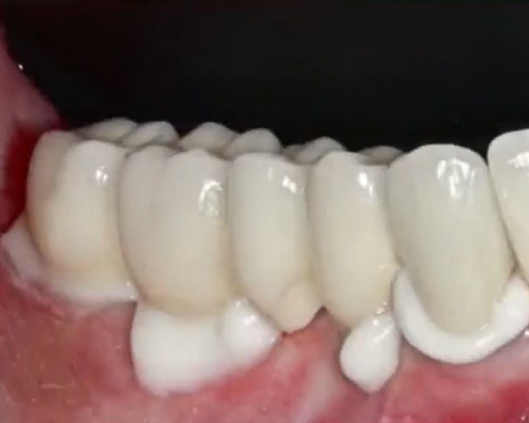
Excessive release of cement from under restoration YouTube / Dr. Kamil Khabiev / Dental Guru Academy
This is a significant drawback cited by proponents of screw retention. However, techniques have been developed to minimize cement extrusion during cementation. A gingival retraction cord around the abutment or prepared tooth effectively blocks cement from penetrating the sulcus, as shown below. Cement residues on the outer surface of the crown are easily removed. Zirconia crowns are often placed with their margins just slightly subgingival (1 mm maximum) or even equigingival, especially when paired with zirconia abutments for optimal aesthetics.
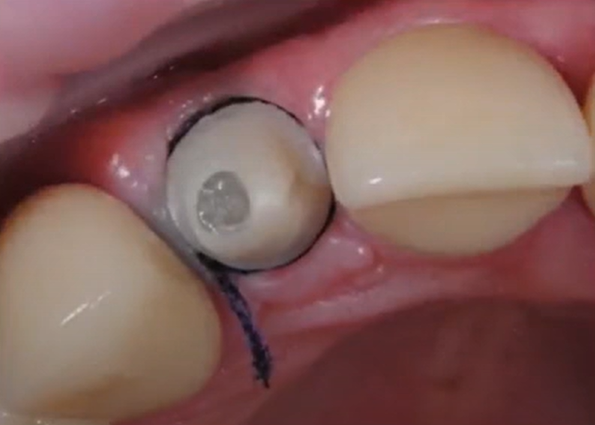
Using gingival floss to protect the subgingival space from penetration of cement residues YouTube / Dr. Kamil Khabiev / Dental Guru Academy
Create a hard silicone index of the jaw area with the abutments in place. The actual abutments should already be secured in the patient’s mouth.
Inject cement into the prosthesis and seat it onto the silicone index for a short time, ensuring the prosthesis is positioned correctly. Excess cement will extrude beyond the crown margins and remain on the silicone, allowing easy removal. A thin cement layer will remain inside the prosthesis, sufficient for reliable retention. Quickly transfer the prosthesis to the patient’s mouth and seat it. If executed correctly, minimal cement will extrude beyond the prosthesis margins. Combining this technique with gingival retraction cord nearly eliminates the risk of cement-related complications. Dual-cure cements are helpful. If you illuminate the remaining cement for 1 second, it loses its paste-like shape, begins to crumble and comes off very easily and is cleaned.
In the next part, we will understand the nuances of screw and cement retention, namely how to cope with errors in the manufacture of prostheses and minimize deviations when installing restorations. We will also analyze several real cases. This will help you decide which cases to use screw retention and which to use cement retention.
Stay tuned for the next publications. - Easily Compensates for Angular Discrepancies Between Implants in Multiple Restorations. The short (approximately 3.5 mm) conical interface between the bridge and multi-unit abutments simplifies creating a well-fitting prosthesis on slightly non-parallel cones. Angled multi-unit abutments can correct even significant implant angulation, as illustrated below.
Disclaimer: Any medical or scientific information provided in connection with the content presented here makes no claim to completeness and the topicality, accuracy and balance of such information provided is not guaranteed. The information provided by XGATE Dental Group GmbH does not constitute medical advice or recommendation and is in no way a substitute for professional advice from a physician, dentist or other healthcare professional and must not be used as a basis for diagnosis or for selecting, starting, changing or stopping medical treatment.
Physicians, dentists and other healthcare professionals are solely responsible for the individual medical assessment of each case and for their medical decisions, selection and application of diagnostic methods, medical protocols, treatments and products.
XGATE Dental Group GmbH does not accept any liability for any inconvenience or damage resulting from the use of the content and information presented here. Products or treatments shown may not be available in all countries and different information may apply in different countries. For country-specific information please refer to our customer service or a distributor or partner of XGATE Dental Group GmbH in your region.
